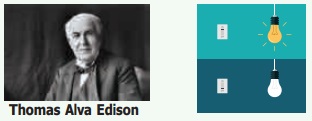Electricity | Term 2 Unit 2 | 6th Science - Conductors and Insulators | 6th Science : Term 2 Unit 2 : Electricity
Chapter: 6th Science : Term 2 Unit 2 : Electricity
Conductors and Insulators
Conductors
and Insulators
Will
electric current pass throw all materials?
If an electric wire is cut, we could see a
metal wire surrounded by another material. Do you know why it is so?

Conductors
The rate of flow of electric charges in a
circuit is called electric current. The materials which allow electric charges to
pass through them are called conductors. Examples: Copper, iron, aluminum, impure water, earth etc.,

Insulators
(Non-Conductors)
The materials which do not allow electric
charges to pass through them are called insulators or non-conductors.
Examples: plastic, glass, wood, rubber, china
clay, ebonite etc.,

Activity 4: Connect the objects given in
the table between A and B and write whether the bulb glows or not.


Safety
measures to safeguard a person from electric shock
I. Switch off the
power supply.
II. Remove the
connection from the switch.
III. Push him away
using non - conducing materials.
IV. Give him first aid and take him to the
nearest health centre.

More to Know
Thomas Alva Edison (February 11,
1847 October 18, 1931) was an American inventor. He invented more than 1000
useful inventions and most of them are electrical appliances used in homes. He
is remembered for the invention of electric bulb.

Activity 5:
Produce electricity using copper
plates, zinc plate, connecting wires, key, beaker and porridge (rice water)
[the older the porridge the better will be the current]
Arrange copper and zinc plates in
series as shown in the figure. Half fill two beakers with porridge. Connect the
copper plate with the positive of and LED bulb and zinc to the negative.
Observe what happens.
Now you can replace porridge with
curd, potato, lemon etc.

Related Topics